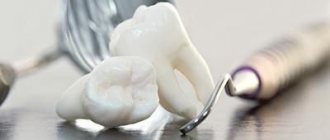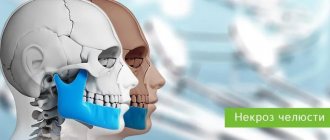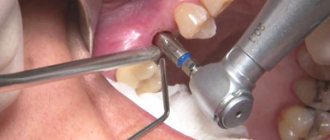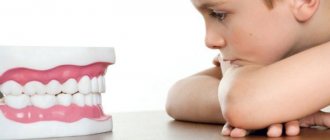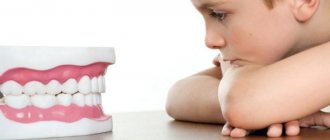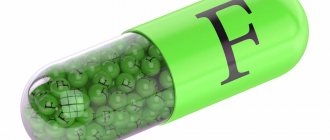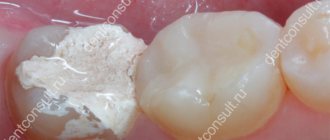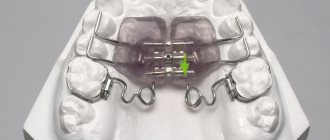4537
Bite correction during the period of changing primary teeth to permanent teeth occurs much easier and faster than moving row elements in adult patients.
For this reason, orthodontic treatment for children does not always require wearing visible and uncomfortable braces.
In most cases, the position of the teeth relative to the jaw line can be corrected using a removable structure - a plate equipped with a Bertoni screw.
General overview
The Bertoni screw is a fastening system that is an integral part of orthodontic leveling plates.
Made from plastic and metal alloy, which has excellent biocompatibility with natural tissues.
The thread and body of the element are made with maximum precision, and the surface of the rod is so smooth that the rotation of the thread and its sliding are very easy and do not cause additional inconvenience while wearing the device.
The design features of the screw completely eliminate its uncontrolled displacement. Main indications for use:
- change in the structure of the upper jaw row towards expansion. The best result can be achieved at the stage of formation of hard bone tissue, which occurs in childhood;
- for single or fragmentary movement of organs. The doctor sets the desired direction and distance within which the displacement must be achieved. These parameters determine the duration of the correction course.
How to install?
After the initial examination, an x-ray is taken, without which it is impossible to prescribe the wearing of orthodontic appliances. If it is necessary to use orthodontic plates for correction, the doctor follows a certain algorithm.
- Before installation, the plate must be manufactured. Since these devices must be strictly individual, it is necessary to make an impression of both jaws of the patient.
- A primary model is then made from plaster and tried on to eliminate even the most minor discrepancies.
- The model serves as the basis for the manufacture of both the plastic base of the plate and other parts. The shape of the plastic should repeat in great detail all the individual features of the palate, as well as the contours of the teeth and gums.
- The penultimate stage is the fitting of the finished product, based on the results of which the doctor can make its correction.
- Since the plates are removable structures, their direct installation does not cause problems. However, the first installation at the dentist's office is important, as the dentist will teach you how to put on and take off the appliance yourself so as not to damage it or harm your teeth.
Peculiarities
Plates with a Bertoni screw are selected individually, taking into account the anatomical features of the patient’s maxillofacial apparatus.
To obtain lasting positive dynamics, the device must be worn almost around the clock, removing it from the oral cavity only when necessary.
The fixation process occurs with the help of special hooks that are quite simply thrown over the teeth. This allows you to remove and put on the system yourself without the help of a specialist.
The principle of operation is to periodically tighten the screw mechanism, thus setting the required pressure force. As a rule, the doctor will do this the first time. Then, during the treatment process, the tension force of the metal arches is adjusted at home.
The Bertoni screw is the active part of the leveling structure. It has several independent guides, which makes it possible to adjust each sector independently. This allows you to stretch the teeth in the desired direction.
A special design advantage of the element is its three-dimensionality, which made it possible to combine two screws together - an expanding and an extending one. Thus, the plate itself has become significantly lighter and thinner.
What is the Brückle apparatus and the stages of its manufacture in the laboratory.
Let's talk here about the effectiveness of Ortho Snap aligners.
At this address https://www.vash-dentist.ru/ortodontiya/kapyi/nevidimyie-elayneryi-star-smile.html you will find reviews about Star Smile aligners.
Types of plates
There are three types of orthodontic leveling mechanisms, each of which has individual indications for use:
- standard plates - used for minor bite defects when serious correction of the anomaly is not required. An ideal solution for giving the correct direction of growth to individual dental elements;
- with the addition of active components - they effectively align fragmented lesions and more complex occlusion pathologies. Such structures have a screw mechanism that regulates the tension force of the plates, which actively influence the direction of tooth growth;
- designs with a Bertoni screw - got their name in honor of their developer.
They make the system as efficient as possible. The main indication for use is correction of children's bite. The plate is less convenient in comparison with analog versions, but the results are several times superior to them.
The video describes in detail the types and principles of operation of the plates.
What does an orthodontic screw in plates look like and what is it for?
This element is also called a lock. It is installed on many corrective structures and is made mainly of stainless steel. There are many types of such mechanisms. Some of them are installed only on the upper jaw, others can work in several directions at once (displace individual dental units, expand rows, etc.).
Screws are a combination of several threaded pins with a thickening in the center, which is called a drum. There are holes in it, it is through them that it is possible to both tighten the dental plate according to the schedule and activate it for the first time. For this, the orthodontist issues a special key.
Such devices are usually installed during periods of change from primary to permanent dentition. The jaw bones are not yet hard enough, so they can be easily corrected.
Screw structures are prescribed for crowded teeth, to reduce or increase the size of the palate, and to eliminate curvature. They are also indicated as part of complex therapy, for example, before a major surgical intervention to restore the functions of the dentofacial apparatus in the presence of an alveolar cleft.
It is quite rare for the mechanisms to be placed on adult patients. This is relevant for minor malocclusions and slight curvature of individual units.
Device characteristics
The product consists of a plastic base, in the center of which there is a screw made of a medical metal alloy. There are arcs along the edges.
Localized parallel to the area of the lateral dental fragments, the arches create the load necessary for the therapeutic effect.
The device is made of medium-hard plastic. The color can be any. In this case, the shape of the plate repeats the palatal relief.
The arc is made of nickel or titanium alloy, and has the ability to “remember” the direction given to it. The thickness of the wire may vary.
The device is attached to special hooks made of the same material as the arcs.
In a number of models, activators are built into the plate, with the help of which the system is controlled. This is very convenient because one device is used throughout the entire correction period.
Preparing the child
Alignment of teeth using this method is indicated at the stage of mixed dentition in a child. At a later age, this procedure is ineffective. Baby teeth are more amenable to correction of anomalies when the pressure force is not too high.
Despite the fact that the correction itself is not a particularly complex manipulation, at all stages of treatment the child should be under the periodic supervision of a dentist.
This requirement is due to the fact that the placement of the organs has not yet been fully formed and incorrect use of the device can cause harm to the teeth, including their complete loss.
The first place to start is visiting an orthodontist. The doctor will examine the oral cavity, evaluate the clinical picture and the degree of neglect of the anomaly, and prescribe an x-ray.
This analysis is a mandatory requirement. It provides more complete information about the condition of the jaw row, since only the crown part of the tooth is on the surface, and everything else is hidden from the eye of a specialist.
Based on the collected medical history, the doctor selects the type of device and gives parents detailed information about the principle of treatment, correct operation and measures for caring for the device.
At the preparatory stage , a treatment plan is developed, the approximate duration of the course, nuances are discussed - when the structure can be removed, how often to do it, how to help the baby quickly adapt to the presence of a foreign object in the mouth and minimize physical discomfort from its use.
Let's sum it up
Before tightening a dental plate for a child, you need to learn how to do it correctly. Immediately after installing the structure, the orthodontist independently activates the device and shows how to regularly adjust it. For this purpose, a special screw mechanism is provided, and the patient’s parents are given a key, which is inserted into the hole and scrolled the required number of times. How many revolutions and how often they need to be done depends on the individual schedule developed by the doctor.
Sometimes during twisting certain difficulties arise. If you take timely measures and go to the clinic, the damaged device can be restored without consequences for the treatment process.
Video on how to properly tighten a plate to straighten teeth:
Correction process
The treatment process begins with making an impression of the jaws. It is made from a wax mass. It is from this copy that the laboratory will form a plaster version of the removable braces.
The template will become the basis for the production of the plate , guaranteeing its maximum compliance with the anatomical features of the structure of the child’s jaws. It completely repeats the relief of the crown part of the tooth and gums.
During a follow-up visit to the doctor, the finished design is tried on, and if there are any discrepancies, adjustments are made. It takes no more than 10 minutes. The doctor shows how to independently change the tension force of the arc .
The specialist also determines the period until which the plate will be used, and with the onset of the first visible improvements, it will be clear what time frame the correction will be limited to.
The system is designed in such a way that a number of its active fragments can cause physical discomfort to a small patient, especially during the period of adaptation.
Sharp fragments rub the mucous membrane and can scratch the tongue. If your baby complains of pain, you should visit a doctor and have the device adjusted.
Since the plate is quite voluminous, adaptation to it occurs gradually. As a rule, the discomfort goes away after 15-20 days. Speech and chewing functions are completely restored.
How comfortable the rehabilitation will be largely depends on the behavior of the parents. Their attention, care and patience will help the child cope with the difficulties of adaptation.
Correction of bite defects using the T4A trainer and the principle of operation of the device.
This material contains detailed information about T4K trainers.
Follow the link https://www.vash-dentist.ru/ortodontiya/prikus/chto-lechit-vrach.html if you are interested in who a pediatric orthodontist is.
Plates or braces for teeth?
This choice cannot stand - dental plates and braces have different functions. The former affect the entire dentition, the latter have a wide range of functions and solve various orthodontic problems: from the curvature of individual teeth to malocclusion and crowding. Also, the plate cannot be placed if the child has developed traumatic periodontitis, in which a fracture of the cortical plate of the tooth is possible. However, these two devices can be used in combination - first the child will be given a plate, and then braces.
Deadlines for correcting defects
How long the treatment will last depends on many factors. Often, even a doctor cannot give such a prognosis at the initial stage.
Here everything depends on the degree of neglect of the anomaly, the hardness of the bone tissue, the age of the patient, and of course, compliance with all the orthodontist’s recommendations.
It is important for parents to understand that bite correction is a long process that requires patience and almost round-the-clock wearing of the plate.
On average, the course of treatment is 2 years, provided that the child uses the system at least 21 hours a day.
Plates with Bertoni screw: design
Pain should not occur when using these orthodontic appliances.
In the first days after their establishment, only unpleasant sensations arise. A person is constantly distracted by a foreign body in the oral cavity. Diction is impaired and sometimes salivation becomes abundant. But then such feelings pass.
If there is no inflammatory process in the gums (complications from wearing plates), wearing them does not hurt. The arc has a gentle effect on the teeth, so they practically do not hurt.
An orthodontic plate consists of a base to which various active elements are attached: hooks, springs, arches. A screw made of medical steel is mounted in the middle. The arches are located along the edges of the base along the lateral teeth, exerting a certain impact on them with a given force. It is attached using hooks placed on the teeth.
During the first visit, the orthodontist attaches the plate to the young patient’s mouth and advises in detail on the rules of use and possible nuances of wearing the structure. Tightens the screw a certain number of turns, achieving reliable fixation. Parents receive the necessary instructions on the further use of the plate: how, when and how many turns to tighten the screw to increase the load on the jaw or dentition, by expanding the base base.
We should not forget that this treatment method is extremely effective when replacing baby teeth with molars. It is very important not to miss a favorable moment.
Bite correcting plates are classified into two categories: removable and non-removable. Each type has its own method of installation, fastening, and special wearing instructions. The orthodontist will select the required type of structure in accordance with the problem being solved.
Removable retainers
Removable structures are popular in pediatric dentistry. Such plates are installed if the child requires minor bite correction.
The staples consist of a plastic base and hooks. Removable retainers do not pose a danger to the child, do not create discomfort while wearing, they can be easily tightened, distributing the necessary load on the jaw.
Plates are complex orthodontic structures of different appearance and functionality for correcting misaligned teeth, both in childhood and in adult patients.
Their size and shape are determined by several factors, including the nature of the anomaly, the age of the patient and the characteristics of his jaws.
Platen installation methods may also vary. Most often they are used to correct minor changes in the position of teeth. In addition, it must be added that the earlier the treatment process begins, the more effective it will be.
Rules of care
Plastic and metal alloy are the main components of the structure. Despite their strength, they can also break.
Moreover, the reason for this may be a banal failure to follow the rules for caring for the device.
For systems to last for a long time, it is necessary:
- Once a day, remove and clean the product with a soft toothbrush and toothpaste that does not contain abrasives;
- carry out weekly antiseptic treatment with formulations specially designed for this purpose;
- Before putting on the device each time, it must be rinsed well with warm boiled water;
- purchase a special container for storing records;
- regularly lubricate the Bertoni screw with oil - just a drop is enough to prevent stagnation of the rotating mechanism;
- do not use the structure while eating;
- avoid mechanical injuries in the jaw area , exclude sports activities associated with the risk of mechanical failure of the product for the entire course of treatment.
Price
The average cost of a leveling plate with a Bertoni screw is about 10,000 rubles. Depending on the place of purchase, this amount can vary between 10 - 15%.
Plates for individual elements are estimated at approximately 2,000 rubles.
At the same time, there are designs whose price is an order of magnitude more expensive - these are products of well-known brands and trademarks. The cost of the system can also be affected by the complexity of its manufacturing.
The course of correction is generally determined by the clinical picture of the pathology, the region of residence of the patient and the status of the clinic where treatment is carried out.
A visit to a specialist for advisory purposes will cost 500–700 rubles.
Correction of bite with plates. Description and principle of treatment
There is a definite difference in the methods of correcting malocclusion in children and adults. It has been proven that the younger the patient, the more simplified version of therapy he needs to carry out a full correction.
This fact is due to the greater flexibility of a not yet fully strengthened organism to changes in the skeletal system.
This feature of human development provides an excellent opportunity to use at an early age the simplest method of straightening uneven teeth - using orthodontic plates.
For adults, this treatment option is not suitable in all cases - their body has already formed and the dental system is very difficult to change. At the same time, it is very noteworthy that people of the older generation are more aware of the reflection of malocclusion on the condition of the body and the appearance of the face.
Specifics of the plate device
The dental plate is intended for use by both adults and children. It has a special strip on the roof of the mouth and so-called brackets, thanks to which the device is secured to the teeth. Sometimes the record has a screw lock. In this version, it is possible to adjust the plastic part.
The plate is in close contact with the palate and partially with the gum area, which is called the lingual area. Over time, the plastic-steel structure moves in the desired direction, thereby leveling the bite. It is worth noting that the plates are used for milder forms of pathologies. In severe cases, a slightly different approach to treatment is needed, for example, using braces.
What types of dental plates are there?
Dental plates are divided into removable and statically fixed. Let us consider in detail the features of each design.
Static, otherwise non-removable dental plates are attached to the front side of the teeth. The system includes a large number of fasteners, reminiscent of miniature locks, connected by a metal arc.
They received this name due to the impossibility of removal by the patient independently, without visiting an orthodontist. The use of such technology makes it possible to correct dental malocclusion for people of all ages - both adults and children.
On average, the adjustment process lasts about one and a half to two years, it all depends on the severity of the pathology.
The photo shows dental plates of various colors and shapes
Removable plates function due to the presence of metal hooks in their design; sometimes additional springs and special screws are built into their systems. A removable device is much easier to use than a non-removable device, is made of high quality plastic and is usually not prescribed for adults.
It is especially convenient when used by teenagers, since the plate can be removed at any time, for example, for eating or for oral hygiene procedures. The duration of removable plate therapy is determined by the orthodontist.
As with the previous option, treatment takes from one and a half to two years, but the device in this case is prescribed to patients who have only a slight deviation from the norm.
It is important to know: there are plates that are used not only to correct the bite and straighten the curvature of the teeth, but also to improve their color. In fourteen days, special plates will give your teeth a pleasant whiteness. Before using them, you should consult with a qualified specialist.
Principle of operation
The photo above shows the base of the device, without the plastic base, which plays a secondary role in the formation of the correct bite of the teeth. Here you can clearly see a metal arc, on both sides of which there are ring-shaped fasteners.
With their help, the plate system is corrected by tightening the screw connecting the two halves of the structure (see previous photo) at intervals set by the doctor.
Such twisting is carried out in order to increase the area of influence of the system on the dental row, as well as to shift the load on one of the jaws, depending on the progress of treatment.
Operating principle of a dental plate for the treatment of malocclusion
The plates are placed individually for each patient. At the same time, their correct location in relation to the gums is selected, which ensures that the patient does not experience any inconvenience when using the system. Even young children do not experience discomfort from wearing correction plates just a few days after installation.
This is what a patient with a dental arch looks like
Different types of plates are adapted for the treatment of any pathologies, so they are divided into types:
- Single jaw type. Designed to align an entire dental row or individual teeth in one row. Adjusting the screws creates the necessary pressure to achieve the desired result.
- To align the teeth of the upper row, plates with a built-in pushing spring are used, which exerts a certain force effect on the teeth.
- Plates in which a refractive arc allows to correct protrusion of the anterior dentition . Protrusion is excessive forward inclination of teeth.
- Plates, the peculiarity of which is the presence of an arc-shaped process , which makes it possible to eliminate severe curvatures of an individual tooth or entire rows of them on any jaw. The tooth(s) are susceptible to movement due to the load created by this process.
Pros and cons of systems
Bite correction using orthodontic plates has the following strengths:
- Removability of the device . This allows you to carry out oral hygiene, eat food and lead a normal lifestyle without any difficulty. Convenience is most valued these days.
- Easy to care for . The procedure for caring for the structure is not difficult even for a child. This fact makes life much easier for parents.
- does not need to be present to a specialist during the creation of the plates. They are produced in a laboratory. More detailed information on this issue should be obtained directly from the attending physician.
Installation by a doctor of removable devices to correct the bite (plates)
Minuses:
- Although the removable plates have many strengths, it can be noted that children often lose the device . After which parents have to re-order and pay for it. Also, if you remove/put on the plate too often, over time this worsens the restorative ability of the device; it will need to be replaced, which will again cost money.
- Plates are not able to move teeth , like braces, for example, they only secure them to maintain their correct position. Therefore, they are not suitable in all cases of bite correction.
- Sometimes the plate is changed to a brace system after a certain period of time or due to the ineffectiveness of therapy.
Colored plates for night correction of bite - an ideal solution for children
To achieve the best results from therapy, some points should be taken into account:
- To achieve the maximum desired effect, the plate must be worn both day and night . Otherwise, the result will not be fully achieved.
- The plates require maintenance. Regular oral hygiene is also necessary. Otherwise, there is a high probability of additional problems arising.
- The plate itself should be cleaned with a specially designated toothbrush, preferably with soft bristles, in order to have less impact on the surface to avoid damage to the system.
- There are two types of gels for the care of fixed plates . There is a gel for daily cleansing (rather superficial), and there is a gel for deep cleaning, but you can use it no more than once a week.
- one night every seven days cleaning the device in a specially designed cleaning liquid.
- When eating, the product should be removed so that possible contamination does not provoke the development of caries.
What is the difference between braces and plates?
When prescribing this or that device, a specialist must be guided by the patient’s age characteristics and the severity of the form of tooth curvature. It must be remembered that under the age of eighteen to twenty years, with an existing slight defect, it is quite simple to correct the bite with plates; in severe cases, braces will be more productive.
Adults with an already formed skeletal system are given plates only at the initial stages of development of tooth curvature; in more complex situations, a completely different approach to treatment is required, since the dental system cannot be easily corrected. In a difficult case, the plate will not have the expected effect, and the funds for its acquisition may be wasted.
How much does plate treatment cost?
The total cost of therapy is affected by the price of the plate and the direct cost of the treatment by a specialist. It makes sense to buy a dental plate only on the recommendation of a specialist.
Combined with the cost of production and installation prices, the price of the plate will vary from 15,000 to 20,000 rubles.
Of course, do not forget that the final cost when using non-removable plates will be slightly higher, since such plates require periodic replacement. Their total cost should be clarified with the treating specialist.
Issues related to correcting a defective bite do not lose relevance to this day, because everyone, young and old, wants to be healthy and beautiful.
Indeed, in many cases it is possible to solve such a problem with minimal inconvenience and without risk to health with the help of a plate selected and recommended by an orthodontist.
You will have to wear it for about 2 years, removing it before eating and maintaining oral hygiene. The result of treatment should be an open and even smile.
Source: //breketov.net/ispravlenie-prikusa-plastinami-opisanie-i-printsip-lecheniya
Reviews
Correction of childhood malocclusion pathologies using plates, in most clinical cases, is an ideal solution and, at the same time, the most popular option from the point of view of patients.
However, the final decision on the advisability of treatment using this device should only be made by a doctor.
If you are interested in the topic discussed in this article, you can leave your comment in the appropriate section.
If you find an error, please select a piece of text and press Ctrl+Enter.
Tags Bertoni screw bite correction plates for teeth straightening
Did you like the article? stay tuned
Previous article
Review of designs and assessment of the aesthetics of ceramic braces with photos
Next article
All the subtleties of using plastic braces to correct bite defects
Advantages of plate correction
If a specific clinical situation allows the possibility of using orthodontic plates to correct defects, then this has certain advantages:
- The devices can be removed for hygiene procedures. This allows you to minimize the risk of developing caries;
- caring for the records is simple and can be done by the child himself;
- devices allow you to solve orthodontic problems at an early age, when it is too early to install braces;
- the plates have affordable prices.
The network of dental clinics “Smile” offers bite treatment services for children using orthodontic plates. We guarantee reasonable prices, a family discount and the quality of correctional therapy at the level of international standards.
Our specialists have a high qualification status and constantly improve their professional level by studying in the best Russian and European dental centers.
Branches of our orthodontic center are located in Moscow within convenient transport and walking distance:
- branch near Alekseevskaya metro station (VDNKh district and Mira Ave.), address: st. 3rd Mytishchinskaya 3, building 2;
- branch in the Shelepikha metro area, address: Shelepikhinskaya embankment, 34, building 1.
We will correct your child's bite using a gentle method using plates. Make an appointment with an orthodontist and find out all the details from a specialist.

